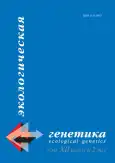Cytogenetic analysis of residents of North Ossetia contacting with toxic factors
- Authors: Chshiyeva F.T.1
-
Affiliations:
- NOSMA
- Issue: Vol 12, No 2 (2014)
- Pages: 68-73
- Section: Articles
- URL: https://journals.rcsi.science/ecolgenet/article/view/2450
- DOI: https://doi.org/10.17816/ecogen12268-73
- ID: 2450
Cite item
Full Text
Abstract
Full Text
##article.viewOnOriginalSite##About the authors
Fatima Taymurazovna Chshiyeva
NOSMA
Email: Fa-2009@yandex.ru
Researcher, Central scientific laboratory
References
- Бочков Н. П. (1974) Метод учета хромосомных повреждений как биологический индикатор влияния факторов внешней среды на человека. М.: Наука.
- Бочков Н. П., Сапачева В. А., Филиппова Т. В. и др. (1993) Цитогенетическое обследование рабочих производства резины. Медицина труда и промышленная экология. № 5-6. С. 12-14.
- Бочков Н. П., Чеботарев А. Н. (1989) Наследственность человека и мутагены внешней среды. М.: Медицина.
- Дурнев А. Д., Середенин С. Б. (1998) Мутагены - скрининг и фармакологическая профилактика воздействий. М.: Медицина.
- Дудкина О. А., Минина В. И., Ларин С. А. и др. (2011) Канцерогены производственной среды и онкологическая заболеваемость на углеперерабатывающих производствах Кузбасса. Политравма. № 1. С. 91-97.
- Дружинин В. Г. (2003 а) Хромосомные нарушения у населения крупного промышленного региона: пространственно-временной цитогенетический мониторинг: Дисс… док. биол. наук. Москва.
- Дружинин В. Г. (2003 б) Количественные характеристики частоты хромосомных аберраций в группе жителей крупного промышленного региона Западной Сибири. Генетика. Т. 39: № 10. С. 1373-1380.
- Дружинин В. Г., Мокрушина Н. В., Минина В. И., Волков А. Н. (2003) Генотоксические эффекты у работников горно-обагатительного производства. Медицина труда и промышленная электроника. № 12. С. 16-20.
- Минина В. И., Дружинин В. Г., Глушков А. Н. и др. (2009) Количественные характеристики частоты хромосомных аберраций у жителей районов с различным уровнем онкологической заболеваемости. Генетика. Т. 45: № 2. С. 239-246.
- Савченко Я. А., Дружинин В. Г., Минина В. И. и др. (2008) Цитогенетический анализ генотоксических эффектов у работников теплоэнергетического производства. Генетика. Т. 44: № 6. С. 857-862.
- Battershill J. M., K. Burnett and S. Bull. (2008) Factors affecting the incidence of genotoxicity biomarkers in peripheral blood lymphocytes: impact on design of biomonitoring studies. Mutagenesis. Р. 1-15.
- Bonassi S., Hagman L., Stromberg U. et al. (2000) Chromosomal aberrations in lymphocytes predict human cancer independently of exposure to carcinogens. European Study Group on Cytogenetic Biomarkers and Health. Cancer Research. Vol. 60. P. 1619-1625.
- Garsia-Leston J, Romma-Torres J, Vilares M. et all (2012) Genotoxic effects of occupational exposure to lead and influence of polymorphisms in genes involved in lead toxicokinetiics and in DNA repair. Environment International. P. 29-36.
- Grover P, Rekhadevi PV, Danadevi K et all (2010) Genotoxicity evaluation in workers occupationally exposed to lead. Int. J. Hyg. Environ. Health. P. 99- 106.
- Hagmar L. et all and the European Study Group on Cytogenetic Biomarkers and Health (1998) Chromosomal Aberrations in Lymphocytes Predict Human Cancer: A Report from the European Study Group on Cytogenetic Biomarkers and Health (ESCH). Cancer Research. Vol. 58. P. 4117-4121.
- Fucic A., Znoar A., Strnad M. et all (2007) Chromosome damage and cancer risk in the workplace: the example of cytogenetic surveillance in Croatia. Toxicol Lett. Vol. 172 (1-2). P. 4-11.
- Rossner P. Jr., Rossnerova A., Sram R. J. (2011) Oxidative stress and chromosomal aberrations in an environmentally Exposed population. Mutation Research. Vol. 707. P. 34-41.
- Singh Z., Chadha P. and Sharma S. (2013) Evaluation of Oxidative Stress and Genotoxicity in Battery Manufacturing Workers Occupationally Exposed to Lead. Toxicol Int. P. 95-100.
- Sram R. J., Rossner P., Smerhovsky Z. (2004) Cytogenetic analysis and occupational health in the Czech Republic. Mutation Research. Vol. 566. P. 21-48.
- Smerhovskya Z., Landaa K., Rossner P. et al. (2002) Increased risk of cancer in radon-exposed miners with elevated frequency of chromosomal aberrations. Mutation Research. Vol. 514. P. 165-176.
- Musak L., Soucek P., Vodickova L. et al. (2008) Chromosomal aberrations in tire plant workers and interaction with polymorphisms of biotransformation and DNA repair genes. Mutation Research. Vol. 641 (1-2) P. 36-42.
Supplementary files






